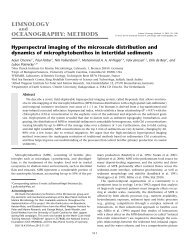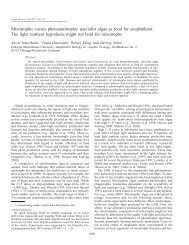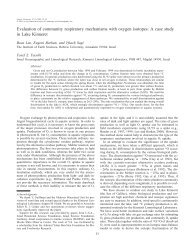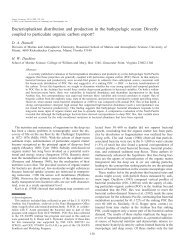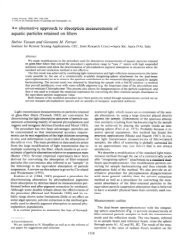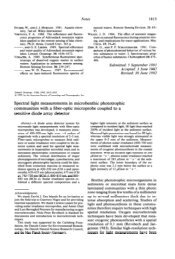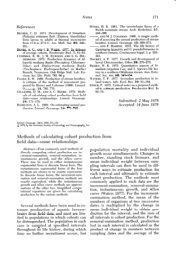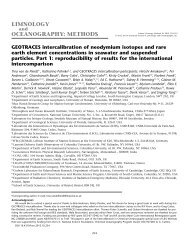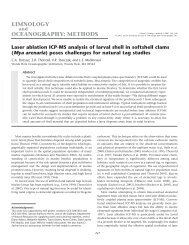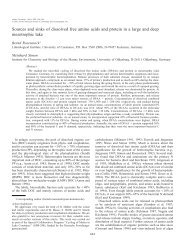Chia Yu Lin and Steven L. Manley. Bromoform production from - ASLO
Chia Yu Lin and Steven L. Manley. Bromoform production from - ASLO
Chia Yu Lin and Steven L. Manley. Bromoform production from - ASLO
You also want an ePaper? Increase the reach of your titles
YUMPU automatically turns print PDFs into web optimized ePapers that Google loves.
Poitiers, the Benemérita Universidad Autónoma de Puebla, the<br />
Universidad de Sevilla, <strong>and</strong> other institutions. He has worked<br />
on algorithms for differential equations, especially boundary<br />
value problems, with application to dynamical systems. He is<br />
the original author of the software AUTO for the bifurcation<br />
analysis of dynamical systems.<br />
D’Alembert Award<br />
Technical Committee on<br />
Multibody Systems <strong>and</strong> Nonlinear<br />
Dynamics<br />
This award was established to<br />
recognize lifelong contributions to the<br />
field of multibody system dynamics.<br />
Javier Garcia de Jalón<br />
Universidad Politécnica de Madrid, Spain<br />
Biographical Description: Professor Javier García de Jalón<br />
was born in Zaragoza (Spain) in 1949. He graduated in<br />
Mechanical Engineering <strong>from</strong> the University of Navarre at San<br />
Sebastián (Spain) in 1971, <strong>and</strong> received his Ph.D. in September<br />
1977 in Computational Mechanics. In 1977 he moved to the<br />
School of Engineering of Bilbao, where he started his work in<br />
kinematics <strong>and</strong> dynamics of multibody systems, becoming a full<br />
professor on Mechanisms <strong>and</strong> Machines in 1980. In 1979 he<br />
started the development of the so-called “natural coordinates”, a<br />
system of generalized coordinates that bypasses the use of<br />
angles to describe the configuration of a multibody system. These<br />
coordinates seamlessly connect the kinematics <strong>and</strong> dynamics of<br />
multibody systems with finite-element models <strong>and</strong> optical motioncapture<br />
systems. Since their initial formulation, these coordinates<br />
have found numerous applications, including to the study of<br />
flexible bodies <strong>and</strong> biomechanics. In 1981 Prof. García de Jalón<br />
returned to San Sebastián <strong>and</strong> until 2000 he worked in the<br />
Applied Mechanics Department of the University of Navarre <strong>and</strong><br />
CEIT (Centre of Technical <strong>and</strong> Research Studies of Gipuzkoa),<br />
where he served as Professor, senior Researcher, <strong>and</strong> Head of<br />
the Department. In 2000 he moved to the Universidad Politécnica<br />
de Madrid, where he is Professor of Applied Mathematics in the<br />
Mechanical Engineering School. He also works for INSIA<br />
(University Institute for Automobile Research), where he develops<br />
methods <strong>and</strong> software for real time simulation, design, <strong>and</strong><br />
parameter identification of vehicles. Prof. García de Jalón has<br />
authored over 80 papers in international Journal <strong>and</strong><br />
Conferences. In 1994 he co-authored with Prof. Bayo the book<br />
“Kinematic <strong>and</strong> Dynamic Simulation of Multibody Systems -The<br />
Real Time Challenge-”, that mostly summarizes the theory on<br />
natural coordinates <strong>and</strong> penalty methods as a way to enforce<br />
kinematic constraints. He has supervised 19 doctoral<br />
dissertations, among them seven university professors. In a 1987<br />
talk at the VIIth IFTóMM World Congress on the Theory of<br />
Machines <strong>and</strong> Mechanisms, in Seville (Spain), he presented a<br />
multibody kinematic <strong>and</strong> dynamic program that ran interactively<br />
with realistic CAD models on one of the first 3-D graphic<br />
workstations. This was the starting point for a large activity of<br />
45<br />
research <strong>and</strong> consulting work for many institutions, including the<br />
ESA (European Space Agency), Mechanical Dynamics, Inc., <strong>and</strong><br />
other Spanish <strong>and</strong> European institutions.<br />
Earl H. Dowell<br />
Duke University<br />
AWARDS AND MEMORIAMS<br />
Lyapunov Award<br />
Technical Committee on Multibody<br />
Systems <strong>and</strong> Nonlinear Dynamics<br />
This award was established to<br />
recognize lifelong contributions to<br />
the field of nonlinear dynamics.<br />
Biographical Description: Prof. Earl H. Dowell received his<br />
B.S. degree <strong>from</strong> the University of Illinois <strong>and</strong> his S.M. <strong>and</strong> Sc.D.<br />
degrees <strong>from</strong> the Massachusetts Institute of Technology. Before<br />
coming to Duke as Dean of the School of Engineering, serving<br />
<strong>from</strong> 1983-1999, he taught at M.I.T. <strong>and</strong> Princeton. He has also<br />
worked with the Boeing Company. Currently he serves on<br />
boards of visitors of Carnegie Mellon University, Georgia Institute<br />
of Technology, Princeton University, University of Illinois <strong>and</strong> the<br />
University of Rochester. He is a consultant to government,<br />
industry <strong>and</strong> universities in science <strong>and</strong> technology policy <strong>and</strong><br />
engineering education as well as on the topics of his research.<br />
Dr. Dowell is an elected member of the National Academy of<br />
Engineering, an Honorary Fellow the American Institute of<br />
Aeronautics <strong>and</strong> Astronautics (AIAA) <strong>and</strong> a Fellow of the<br />
American Academy of Mechanics <strong>and</strong> the American Society of<br />
Mechanical Engineers. He has also served as Vice President for<br />
Publications <strong>and</strong> member of the Executive Committee of the<br />
Board of Directors of the AIAA, as a member of the United<br />
States Air Force Scientific Advisory Board, the Air Force Studies<br />
Board, the AGARD (NATO) advisory panel for aerospace<br />
engineering, as President of the American Academy of<br />
Mechanics, Chair of the US National Committee on Theoretical<br />
<strong>and</strong> Applied Mechanics <strong>and</strong> as Chairman of the National<br />
Council of Deans of Engineering. From the AIAA he has received<br />
the Structure, Structural Dynamics <strong>and</strong> Materials Award, the<br />
Von Karman Lectureship <strong>and</strong> the Crichlow Prize; <strong>from</strong> the<br />
ASME he has received the Spirit of St. Louis Medal <strong>and</strong> Den<br />
Hartog Award; <strong>and</strong> he has also received the Guggenheim Medal<br />
which is awarded jointly by the AIAA, ASME, AHS <strong>and</strong> SAE. Dr.<br />
Dowell research ranges over the topics of aeroelasticity,<br />
nonsteady aerodynamics <strong>and</strong> nonlinear dynamics. In addition<br />
to being author of over two hundred research articles, Dr. Dowell<br />
is the author or co-author of four books, “Aeroelasticity of Plates<br />
<strong>and</strong> Shells”, “A Modern Course in Aeroelasticity”, “Studies in<br />
Nonlinear Aeroelasticity” <strong>and</strong> “Dynamics of Very High<br />
Dimensional Systems”. His teaching spans the disciplines of<br />
acoustics, aerodynamics, <strong>and</strong> dynamics.




